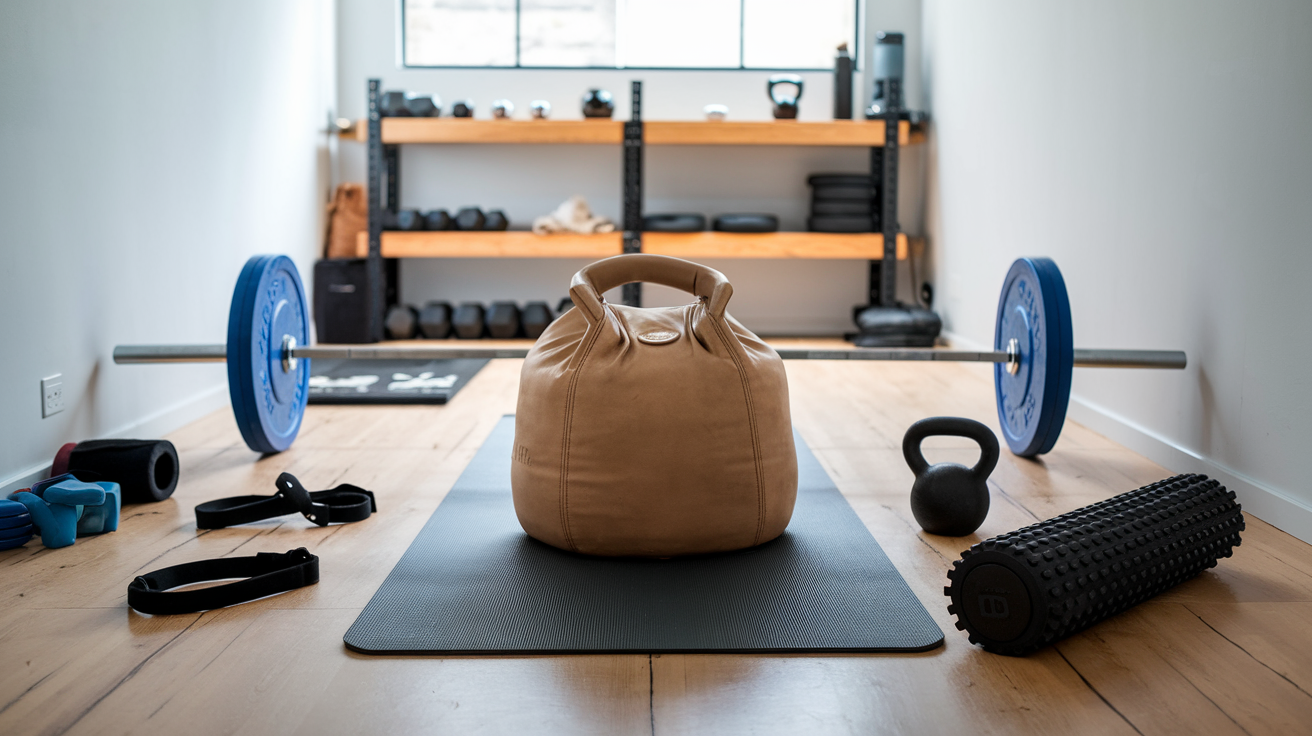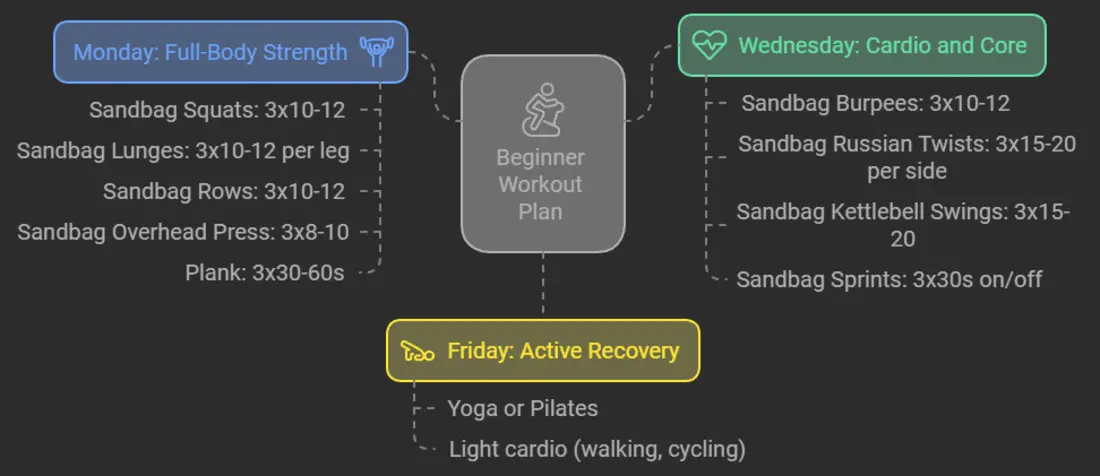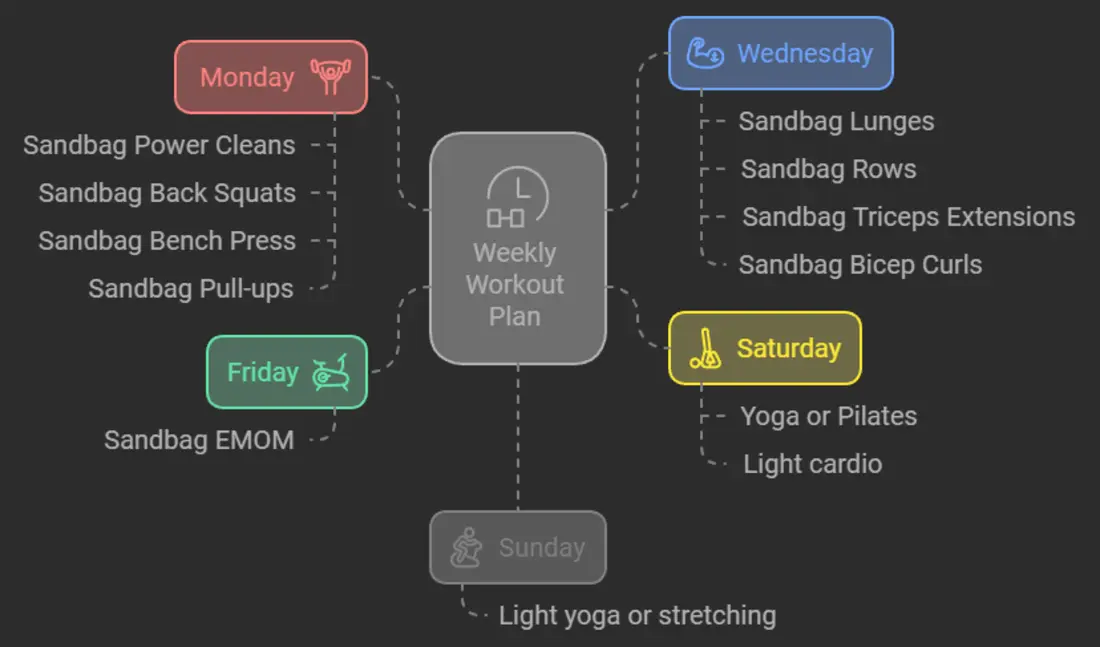Tired of the same old dumbbell routine?
Ready to level up your home workouts? Ditch the dumbbells and grab a sandbag.
This versatile tool is all you need to build muscle, burn fat, and sculpt your dream physique.

Sandbags aren’t just for strongmen. They’re a fantastic way to challenge your body in new ways, whether you’re a beginner or a seasoned fitness enthusiast.
From full-body workouts to targeted muscle training, sandbags offer endless possibilities.
In this guide, we’ll break down the benefits of sandbag training, show you some killer exercises, and provide workout plans for all fitness levels.
So, get ready to transform your home workouts and achieve your fitness goals with a single, powerful tool.
The Power of Sandbags – A Comprehensive Guide
What is Sandbag Training?
Sandbag training is a dynamic form of strength and conditioning that utilizes unstable, irregular weights.
Unlike traditional weightlifting, sandbags constantly shift and change, forcing your muscles to adapt and work harder.
This unique characteristic makes sandbag training a highly effective way to build functional strength, improve stability, and enhance athletic performance.
Unique Benefits of Sandbag Training
- Functional Strength: Sandbags mimic real-life movements, building practical strength that translates to everyday activities and athletic performance.
- Core Powerhouse: The unstable nature of sandbags forces your core muscles to work overtime, leading to improved stability and balance.
- Iron Grip: Grappling with sandbags strengthens your grip, making everyday tasks easier and enhancing your athletic performance.
- Cardiovascular Boost: Elevate your heart rate and torch calories with intense sandbag workouts, improving your cardiovascular health.
- Budget-Friendly Fitness: Say goodbye to expensive gym memberships. Sandbags are a cost-effective way to get a full-body workout at home.
- Versatile and Portable: Take your workout anywhere. Sandbags are compact and easy to transport, making them perfect for home workouts or outdoor training.
The Science Behind Sandbag Training
Sandbag training isn’t just a trend; it’s a scientifically proven method to enhance your fitness journey.
Let’s delve into the reasons why sandbag workouts are so effective:
Muscle Activation and Engagement
The constantly shifting nature of sandbags forces your muscles to work harder to stabilize and control the weight.
This increased muscle activation leads to faster strength and muscle growth.
Unstable Load and Core Stability
Unlike traditional weightlifting, sandbags challenge your core muscles to stabilize your body as you lift and move the weight.
This increased core engagement translates to improved balance, stability, and overall functional fitness.
Real-World Strength and Functional Fitness
Sandbag exercises mimic real-life movements, such as lifting heavy objects or carrying groceries.
This functional strength training helps you perform everyday tasks with greater ease and reduces the risk of injuries.
A Table Comparing Sandbag Training to Traditional Weightlifting
| Feature | Sandbag Training | Traditional Weightlifting |
|---|---|---|
| Equipment Versatility | Highly versatile, one tool for many exercises | Requires various machines or free weights |
| Muscle Activation | Engages stabilizer muscles due to instability | Primarily targets primary muscle groups |
| Functional Strength | Mimics real-world movements, improving functional fitness | More focused on isolated muscle groups |
| Injury Risk | Lower risk of injury due to dynamic nature | Higher risk of injury if proper form is not maintained |
| Cost-Effectiveness | Relatively low cost, often requiring minimal equipment | Can be expensive, especially with gym memberships and equipment purchases |
Essential Sandbag Exercises

Now that you understand the science behind sandbag training, let’s explore some fundamental exercises to get you started.
Compound Movements
- Sandbag Squats: A classic exercise that targets your quads, hamstrings, and glutes.
- Sandbag Lunges: A great exercise for building lower body strength and improving balance.
- Sandbag Presses: A challenging upper body exercise that targets your shoulders and triceps.
- Sandbag Deadlifts: A powerful exercise that works your back, core, and legs.
- Sandbag Rows: A versatile exercise that targets your back and biceps.
Core Exercises
- Sandbag Planks: A static exercise that engages your core, shoulders, and back.
- Russian Twists: A dynamic exercise that targets your obliques and core.
- Leg Raises: A classic core exercise that strengthens your lower abs.
Cardio Exercises
- Sandbag Sprints: A high-intensity exercise that burns calories and improves cardiovascular health.
- Sandbag Burpees: A full-body exercise that combines strength and cardio.
Remember to start with lighter weights and gradually increase the weight as you get stronger.
Always prioritize proper form to avoid injuries and maximize results.
Creating a Home Gym with Sandbags

Essential Equipment
- Sandbag: The core of your home gym. Choose a sandbag that’s adjustable in weight and has comfortable handles.
- Sandbag Gloves: Protect your hands from blisters and calluses, especially during heavy lifting.
- Floor Mats: A good quality floor mat can protect your floor from damage and provide a comfortable surface for your workouts.
Space Considerations and Setup Tips
- Minimal Space: Even a small corner of your home can be transformed into a functional home gym.
- Clear Space: Ensure you have enough space to move freely and perform exercises without hitting any obstacles.
- Ventilation: Good ventilation is essential, especially during intense workouts.
- Storage: Find a convenient place to store your sandbag and other equipment when not in use.
- Safety First: Clear the area of any potential hazards before starting your workout.
With a sandbag and a little space, you can create a dynamic and effective home gym that will help you achieve your fitness goals.
Sandbag Workout Routines for All Fitness Levels
Beginner Workout (3 days/week)

Monday: Full-Body Strength
- Sandbag Squats: 3 sets of 10-12 reps
- Sandbag Lunges: 3 sets of 10-12 reps per leg
- Sandbag Rows: 3 sets of 10-12 reps
- Sandbag Overhead Press: 3 sets of 8-10 reps
- Plank: 3 sets of 30-60 seconds
Wednesday: Cardio and Core
- Sandbag Burpees: 3 sets of 10-12 reps
- Sandbag Russian Twists: 3 sets of 15-20 reps per side
- Sandbag Kettlebell Swings: 3 sets of 15-20 reps
- Sandbag Sprints: 3 sets of 30 seconds on, 30 seconds off
Friday: Active Recovery
- Yoga or Pilates
- Light cardio (walking, cycling)
Intermediate Workout (4 days/week)

Monday: Strength and Power
- Sandbag Clean and Jerk: 3 sets of 5-8 reps
- Sandbag Deadlifts: 3 sets of 8-10 reps
- Sandbag Push Press: 3 sets of 8-10 reps
- Sandbag Farmer’s Carry: 3 sets of 30-60 seconds per side
Wednesday: Circuit Training
- Sandbag Burpees: 10 reps
- Sandbag Kettlebell Swings: 15 reps
- Sandbag Thrusters: 10 reps
- Sandbag Plank: 30-60 seconds
- Repeat 3-4 times
Friday: Active Recovery
- Yoga or Pilates
- Light cardio (swimming, cycling)
Saturday: Metabolic Conditioning
- Sandbag AMRAP (As Many Reps As Possible): 20 minutes of alternating between sandbag thrusters, sandbag swings, and burpees
Advanced Workout (5 days/week)

Monday: Strength
- Sandbag Power Cleans: 3 sets of 3-5 reps
- Sandbag Back Squats: 3 sets of 5-8 reps
- Sandbag Bench Press: 3 sets of 8-10 reps
- Sandbag Pull-ups: 3 sets of as many reps as possible
Wednesday: Hypertrophy
- Sandbag Lunges: 4 sets of 10-12 reps per leg
- Sandbag Rows: 4 sets of 12-15 reps
- Sandbag Triceps Extensions: 4 sets of 12-15 reps
- Sandbag Bicep Curls: 4 sets of 12-15 reps
Friday: Metabolic Conditioning
- Sandbag EMOM (Every Minute On the Minute): Alternate between sandbag thrusters, sandbag swings, and rest for 20 minutes.
Saturday: Active Recovery
- Yoga or Pilates
- Light cardio (swimming, cycling)
Sunday: Rest or Optional Light Workout
- Light yoga or stretching
Remember: Always listen to your body and adjust the workout to your fitness level. Proper form is crucial to prevent injuries and maximize results.
Incorporating Sandbag Training into Other Modalities
Sandbag training is incredibly versatile and can be integrated into various fitness modalities to enhance your workouts and challenge your body in new ways.
Sandbags and Yoga/Pilates
- Added Resistance: Incorporate sandbags into yoga or Pilates poses to provide additional resistance, challenging your strength and stability.
- Enhanced Poses: Use sandbags to modify traditional poses like Warrior I, Warrior II, and Plank. For example, holding a sandbag during a Warrior pose can increase the intensity of the exercise.
Sandbags and CrossFit
- CrossFit WODs: Sandbags can be used to replace or supplement traditional CrossFit equipment, adding a unique challenge to your workouts.
- Functional Fitness: Sandbag workouts align with the functional fitness principles of CrossFit, focusing on strength, power, and endurance.
Sandbags and Traditional Weightlifting
- Strength and Power: Incorporate sandbag exercises into your weightlifting routine to develop explosive power and functional strength.
- Accessory Work: Use sandbags for accessory exercises like farmer’s walks, loaded carries, and rotational movements to improve grip strength and core stability.
By combining sandbag training with other modalities, you can create dynamic and effective workouts that target multiple fitness goals.
Nutrition and Recovery for Sandbag Training

Proper nutrition and recovery are essential for optimizing your sandbag training performance.
Let’s explore key strategies to fuel your body and aid in recovery.
Pre-Workout Nutrition
- Carbohydrates: Consume complex carbohydrates like whole grains, fruits, and vegetables to provide sustained energy.
- Protein: A small amount of protein can help repair and build muscle tissue.
- Hydration: Drink plenty of water to stay hydrated before your workout.
Post-Workout Recovery
- Protein and Carbohydrates: Consume a combination of protein and carbohydrates to replenish glycogen stores and repair muscle tissue.
- Hydration: Replenish fluids lost during the workout by drinking water or a sports drink.
- Supplements: Consider supplements like protein powder or creatine to support muscle recovery and growth.
Hydration Guidelines
- Stay Hydrated: Drink water throughout the day, especially during and after intense workouts.
- Monitor Fluid Loss: Pay attention to your urine color, as dark yellow urine indicates dehydration.
- Electrolyte Replacement: If you sweat heavily, consider consuming sports drinks to replenish electrolytes.
Supplement Considerations
- Protein Powder: Can be a convenient way to increase protein intake, especially for those who struggle to meet their daily protein needs.
- Creatine: May improve muscle strength and power, but consult with a healthcare professional before starting any new supplement.
- Consult a Professional: Seek advice from a registered dietitian or sports nutritionist to create a personalized nutrition plan.
By fueling your body with the right nutrients and prioritizing recovery, you can maximize your performance and minimize the risk of injury.
Common Mistakes and How to Avoid Them
Even experienced fitness enthusiasts can make mistakes.
By identifying and addressing these common errors, you can optimize your sandbag training and minimize the risk of injury.
Form Errors
- Rounding Your Back: Maintain a neutral spine during exercises like squats and deadlifts.
- Swinging the Weight: Use controlled movements to avoid momentum and maintain proper form.
- Gripping Too Tightly: Relax your grip to reduce stress on your hands and forearms.
Programming Mistakes
- Imbalance: Ensure a balanced workout that targets all major muscle groups.
- Overtraining: Listen to your body and avoid overtraining by incorporating rest days and active recovery.
- Lack of Progression: Gradually increase the weight, repetitions, or sets to continue challenging your muscles.
Recovery Considerations
- Rest and Sleep: Prioritize adequate sleep to allow your body to repair and recover.
- Nutrition: Fuel your body with a balanced diet that includes protein, carbohydrates, and healthy fats.
- Hydration: Stay hydrated to optimize performance and prevent dehydration.
By avoiding these common mistakes and prioritizing safety, you can maximize the benefits of sandbag training and achieve your fitness goals.
Frequently Asked Questions
Is sandbag training safe for beginners?
Yes, sandbag training can be safe for beginners when done correctly. Start with lighter weights and gradually increase the intensity as you get stronger. Always prioritize proper form and listen to your body.
Can sandbag training help me lose weight?
Absolutely! Sandbag training is a great way to burn calories and build muscle, both of which contribute to weight loss. The high-intensity nature of many sandbag exercises can lead to increased calorie expenditure and fat loss.
Can I use sandbags for cardio workouts?
Yes, you can incorporate sandbags into your cardio routine by doing exercises like sandbag sprints, hill sprints, or weighted cardio. These dynamic movements will elevate your heart rate and improve your cardiovascular fitness.
How often should I train with sandbags?
The frequency of your sandbag training depends on your fitness level and goals. Beginners can start with 2-3 sessions per week, while more advanced individuals may train 4-5 times per week.
What are the benefits of sandbag training compared to traditional weightlifting?
Sandbag training offers several advantages over traditional weightlifting:
- Functional Strength: Sandbags mimic real-life movements, building practical strength that translates to everyday activities.
- Core Activation: The unstable nature of sandbags forces your core muscles to work harder, leading to improved stability and balance.
- Injury Prevention: Sandbag training can help reduce the risk of injuries by strengthening supporting muscles and improving overall physical conditioning.
- Versatility: Sandbags can be used for a wide range of exercises, making them a versatile tool for home workouts.
Remember to consult with a healthcare professional before starting any new workout regimen, especially if you have any underlying health conditions.
Conclusion
Sandbag training offers a dynamic and effective way to enhance your fitness journey.
By understanding the science behind sandbag training, mastering fundamental exercises, and incorporating this modality into your routine, you can achieve significant results.
Key Takeaways
- Sandbag training offers numerous benefits, including increased strength, power, and functional fitness.
- It’s adaptable for all fitness levels, from beginners to advanced athletes.
- Sandbags can be used for a wide range of exercises, targeting various muscle groups.
- Proper form, progressive overload, and adequate recovery are essential for optimal results.
Call to Action
Ready to transform your workouts?
Start your sandbag training journey today!
Incorporate these exercises into your routine, experiment with different techniques, and embrace the challenge.
Remember, consistency is key.
Stay committed, listen to your body, and enjoy the process of achieving your fitness goals.
Are you ready to unlock your full potential with sandbag training?
Share your experiences and questions in the comments. Let’s inspire each other to reach new fitness heights!
Reference
Effects of 12-Week Progressive Sandbag Exercise Training on Glycemic Control and Muscle Strength in Patients: National Institutes of Health (NIH) (.gov)



